Criminology: Social Inequality, Penal Theory, Policy, and Practice
VerifiedAdded on 2021/01/02
|9
|3138
|181
Report
AI Summary
This report provides a comprehensive analysis of penal theory, policy, and practice within the field of criminology, with a specific focus on social inequality and its impact on the criminal justice system. The report begins by highlighting the disparities in the treatment of individuals committing similar crimes, emphasizing how bias based on class, race, and gender affects outcomes at various stages, from investigation to sentencing. It then delves into discrimination against the poor, exploring how socioeconomic status influences perceptions, investigations, and sentencing. The report also examines historical and ongoing inequalities, highlighting how media sensationalism contributes to societal perceptions and biases within the justice system. Finally, it suggests that media and education can play a crucial role in mitigating disparities. The report underscores the importance of addressing social inequalities to create a more equitable and just criminal justice system.

Criminology - Penal Theory
Policy and Practice
Policy and Practice
Paraphrase This Document
Need a fresh take? Get an instant paraphrase of this document with our AI Paraphraser
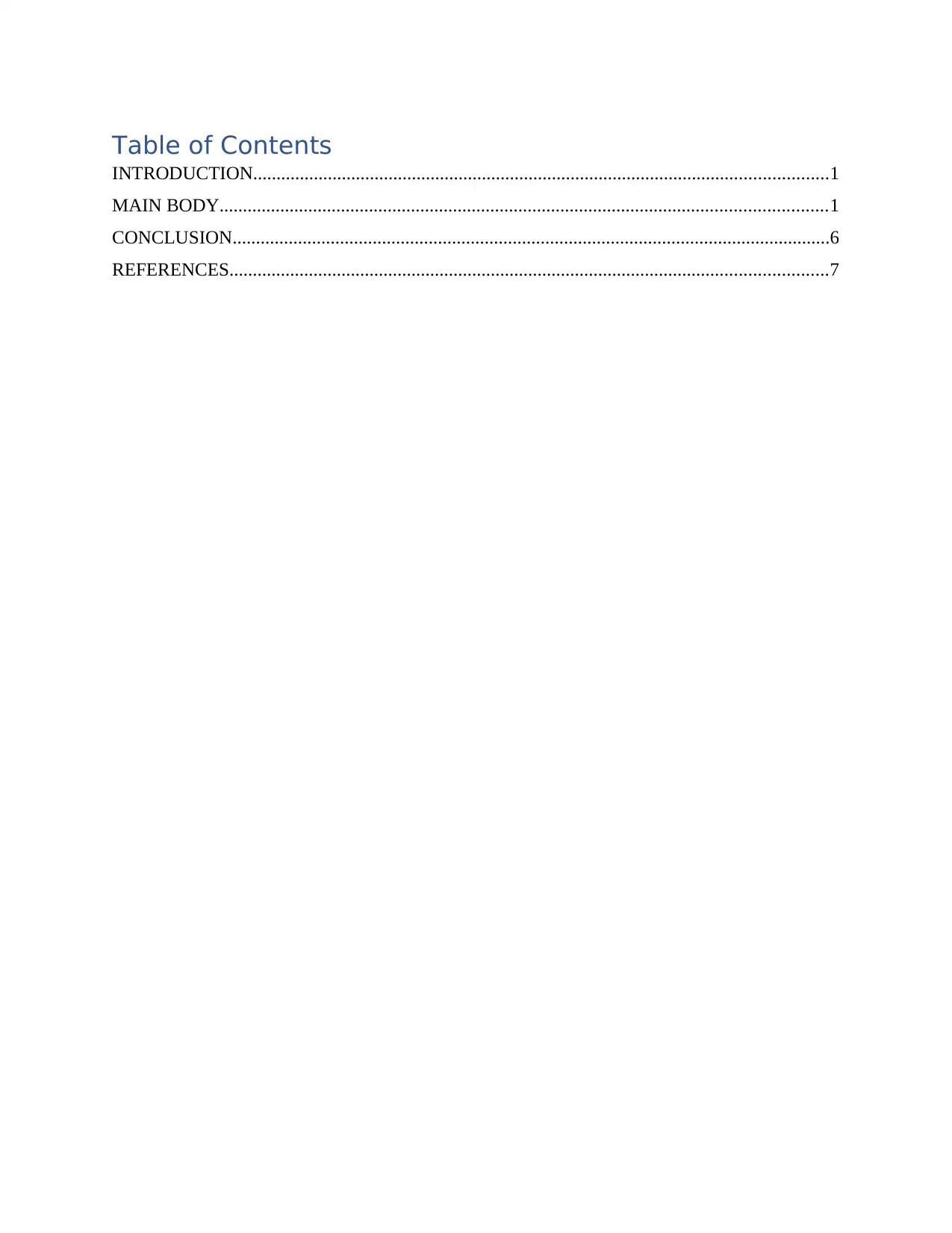
Table of Contents
INTRODUCTION...........................................................................................................................1
MAIN BODY..................................................................................................................................1
CONCLUSION................................................................................................................................6
REFERENCES................................................................................................................................7
INTRODUCTION...........................................................................................................................1
MAIN BODY..................................................................................................................................1
CONCLUSION................................................................................................................................6
REFERENCES................................................................................................................................7

INTRODUCTION
Social disparity is the common issue that has been faced by the country even after having
various social equality laws and provisions. The report makes a comprehensive discussion
regarding various social inequalities aspects in the country which have been affecting criminal
justice system as well. The report will then make a discussion regarding how discrimination with
the poor is actually conducted while analysing any criminal activities or during its process. In the
ends, the report will make discussion regarding various approaches that can be used in the form
of media and education so as to ensure that disparity related activities can be mitigated.
MAIN BODY
Paragraph 1: Social inequality / Politics
From assessment, it has been identified that when two people are committing crime of
similar seriousness then they are equally accountable for punishment. On the basis of this aspect,
in case of departing from equality, there must be suitable differences and justification. Through
evaluating articles, it has been found that England and Wales get failed to employ or undertake
similar treatment in against to the individuals who committed same crime or undesirable acts.
Under criminal justice system, biasness takes place on the basis of class, race and gender
(Beckett and Western, 2001). Usually, biasness occurs at sentencing stage or even within the
penal system in against to a wider criminal justice system. Inequality or biasness occurs at each
and every stage of the criminal process. Hence, biasness starts with the stage where investigation
and charges are taken by Police.
In addition to this, inequality has also assessed in the prosecution decisions taken by the
crown service, decisions related to bail, court verdicts and sentencing aspects. Thus, it can be
presented that biasness arises usually after sentencing. In addition to this, penal system cannot be
viewed or considered in isolation while considering issues pertaining to biasness. In context of
criminal justice system, biasness or inequality arises due to the several reasons. Laws and
legislation lay emphasis on avoiding discrimination on the basis of age, gender, religion,
disability and sexual orientation. Irrespective of existence of Equality Act 2010, discriminatory
practices are taking place in the penal system.
Paragraph 2: Discrimination against the poor in the CJS
Researchers have stated significant biasness in fundamental principle of justice. It is
important that all the like cases must be treated alike only. If two individuals have been involved
1
Social disparity is the common issue that has been faced by the country even after having
various social equality laws and provisions. The report makes a comprehensive discussion
regarding various social inequalities aspects in the country which have been affecting criminal
justice system as well. The report will then make a discussion regarding how discrimination with
the poor is actually conducted while analysing any criminal activities or during its process. In the
ends, the report will make discussion regarding various approaches that can be used in the form
of media and education so as to ensure that disparity related activities can be mitigated.
MAIN BODY
Paragraph 1: Social inequality / Politics
From assessment, it has been identified that when two people are committing crime of
similar seriousness then they are equally accountable for punishment. On the basis of this aspect,
in case of departing from equality, there must be suitable differences and justification. Through
evaluating articles, it has been found that England and Wales get failed to employ or undertake
similar treatment in against to the individuals who committed same crime or undesirable acts.
Under criminal justice system, biasness takes place on the basis of class, race and gender
(Beckett and Western, 2001). Usually, biasness occurs at sentencing stage or even within the
penal system in against to a wider criminal justice system. Inequality or biasness occurs at each
and every stage of the criminal process. Hence, biasness starts with the stage where investigation
and charges are taken by Police.
In addition to this, inequality has also assessed in the prosecution decisions taken by the
crown service, decisions related to bail, court verdicts and sentencing aspects. Thus, it can be
presented that biasness arises usually after sentencing. In addition to this, penal system cannot be
viewed or considered in isolation while considering issues pertaining to biasness. In context of
criminal justice system, biasness or inequality arises due to the several reasons. Laws and
legislation lay emphasis on avoiding discrimination on the basis of age, gender, religion,
disability and sexual orientation. Irrespective of existence of Equality Act 2010, discriminatory
practices are taking place in the penal system.
Paragraph 2: Discrimination against the poor in the CJS
Researchers have stated significant biasness in fundamental principle of justice. It is
important that all the like cases must be treated alike only. If two individuals have been involved
1
⊘ This is a preview!⊘
Do you want full access?
Subscribe today to unlock all pages.

Trusted by 1+ million students worldwide
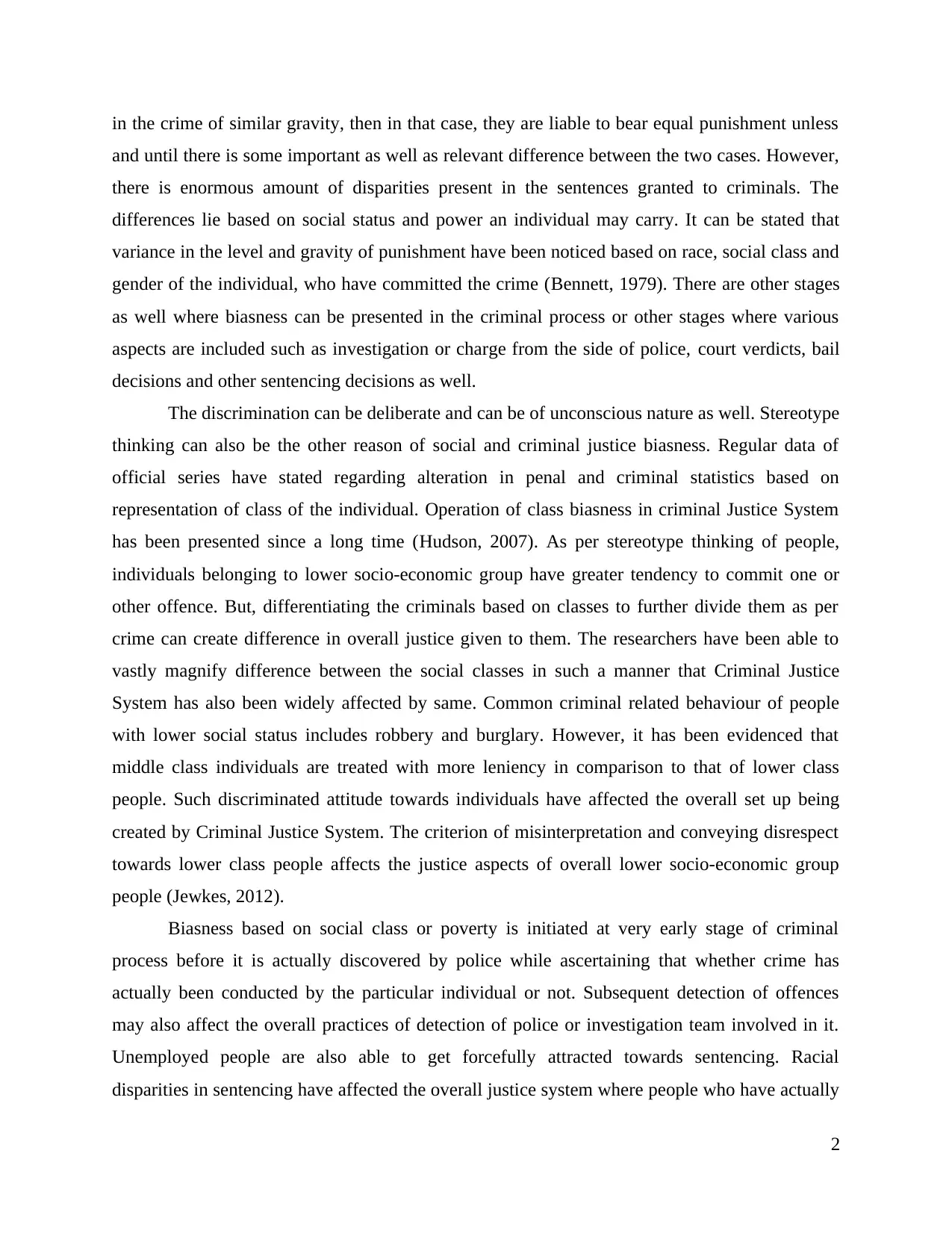
in the crime of similar gravity, then in that case, they are liable to bear equal punishment unless
and until there is some important as well as relevant difference between the two cases. However,
there is enormous amount of disparities present in the sentences granted to criminals. The
differences lie based on social status and power an individual may carry. It can be stated that
variance in the level and gravity of punishment have been noticed based on race, social class and
gender of the individual, who have committed the crime (Bennett, 1979). There are other stages
as well where biasness can be presented in the criminal process or other stages where various
aspects are included such as investigation or charge from the side of police, court verdicts, bail
decisions and other sentencing decisions as well.
The discrimination can be deliberate and can be of unconscious nature as well. Stereotype
thinking can also be the other reason of social and criminal justice biasness. Regular data of
official series have stated regarding alteration in penal and criminal statistics based on
representation of class of the individual. Operation of class biasness in criminal Justice System
has been presented since a long time (Hudson, 2007). As per stereotype thinking of people,
individuals belonging to lower socio-economic group have greater tendency to commit one or
other offence. But, differentiating the criminals based on classes to further divide them as per
crime can create difference in overall justice given to them. The researchers have been able to
vastly magnify difference between the social classes in such a manner that Criminal Justice
System has also been widely affected by same. Common criminal related behaviour of people
with lower social status includes robbery and burglary. However, it has been evidenced that
middle class individuals are treated with more leniency in comparison to that of lower class
people. Such discriminated attitude towards individuals have affected the overall set up being
created by Criminal Justice System. The criterion of misinterpretation and conveying disrespect
towards lower class people affects the justice aspects of overall lower socio-economic group
people (Jewkes, 2012).
Biasness based on social class or poverty is initiated at very early stage of criminal
process before it is actually discovered by police while ascertaining that whether crime has
actually been conducted by the particular individual or not. Subsequent detection of offences
may also affect the overall practices of detection of police or investigation team involved in it.
Unemployed people are also able to get forcefully attracted towards sentencing. Racial
disparities in sentencing have affected the overall justice system where people who have actually
2
and until there is some important as well as relevant difference between the two cases. However,
there is enormous amount of disparities present in the sentences granted to criminals. The
differences lie based on social status and power an individual may carry. It can be stated that
variance in the level and gravity of punishment have been noticed based on race, social class and
gender of the individual, who have committed the crime (Bennett, 1979). There are other stages
as well where biasness can be presented in the criminal process or other stages where various
aspects are included such as investigation or charge from the side of police, court verdicts, bail
decisions and other sentencing decisions as well.
The discrimination can be deliberate and can be of unconscious nature as well. Stereotype
thinking can also be the other reason of social and criminal justice biasness. Regular data of
official series have stated regarding alteration in penal and criminal statistics based on
representation of class of the individual. Operation of class biasness in criminal Justice System
has been presented since a long time (Hudson, 2007). As per stereotype thinking of people,
individuals belonging to lower socio-economic group have greater tendency to commit one or
other offence. But, differentiating the criminals based on classes to further divide them as per
crime can create difference in overall justice given to them. The researchers have been able to
vastly magnify difference between the social classes in such a manner that Criminal Justice
System has also been widely affected by same. Common criminal related behaviour of people
with lower social status includes robbery and burglary. However, it has been evidenced that
middle class individuals are treated with more leniency in comparison to that of lower class
people. Such discriminated attitude towards individuals have affected the overall set up being
created by Criminal Justice System. The criterion of misinterpretation and conveying disrespect
towards lower class people affects the justice aspects of overall lower socio-economic group
people (Jewkes, 2012).
Biasness based on social class or poverty is initiated at very early stage of criminal
process before it is actually discovered by police while ascertaining that whether crime has
actually been conducted by the particular individual or not. Subsequent detection of offences
may also affect the overall practices of detection of police or investigation team involved in it.
Unemployed people are also able to get forcefully attracted towards sentencing. Racial
disparities in sentencing have affected the overall justice system where people who have actually
2
Paraphrase This Document
Need a fresh take? Get an instant paraphrase of this document with our AI Paraphraser
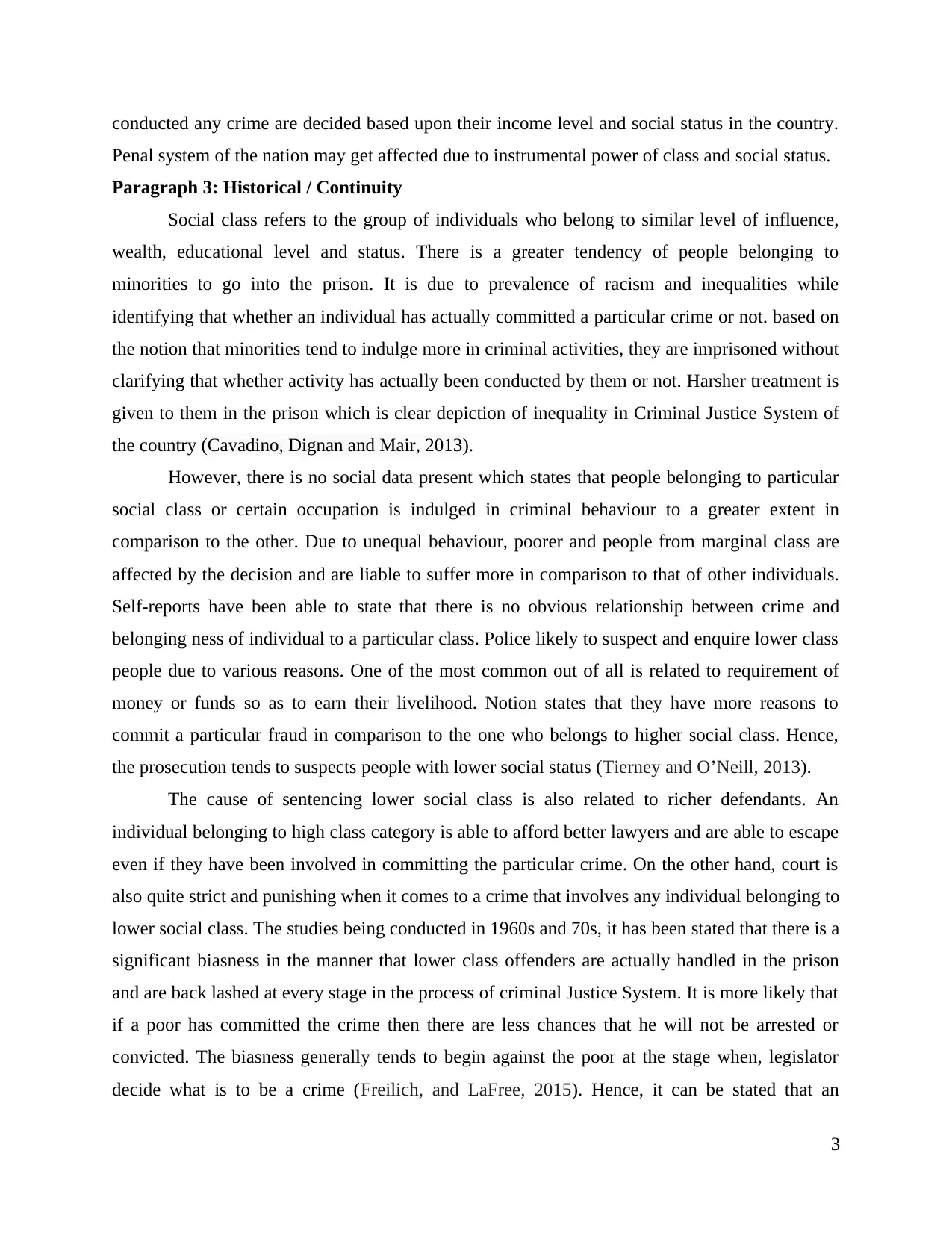
conducted any crime are decided based upon their income level and social status in the country.
Penal system of the nation may get affected due to instrumental power of class and social status.
Paragraph 3: Historical / Continuity
Social class refers to the group of individuals who belong to similar level of influence,
wealth, educational level and status. There is a greater tendency of people belonging to
minorities to go into the prison. It is due to prevalence of racism and inequalities while
identifying that whether an individual has actually committed a particular crime or not. based on
the notion that minorities tend to indulge more in criminal activities, they are imprisoned without
clarifying that whether activity has actually been conducted by them or not. Harsher treatment is
given to them in the prison which is clear depiction of inequality in Criminal Justice System of
the country (Cavadino, Dignan and Mair, 2013).
However, there is no social data present which states that people belonging to particular
social class or certain occupation is indulged in criminal behaviour to a greater extent in
comparison to the other. Due to unequal behaviour, poorer and people from marginal class are
affected by the decision and are liable to suffer more in comparison to that of other individuals.
Self-reports have been able to state that there is no obvious relationship between crime and
belonging ness of individual to a particular class. Police likely to suspect and enquire lower class
people due to various reasons. One of the most common out of all is related to requirement of
money or funds so as to earn their livelihood. Notion states that they have more reasons to
commit a particular fraud in comparison to the one who belongs to higher social class. Hence,
the prosecution tends to suspects people with lower social status (Tierney and O’Neill, 2013).
The cause of sentencing lower social class is also related to richer defendants. An
individual belonging to high class category is able to afford better lawyers and are able to escape
even if they have been involved in committing the particular crime. On the other hand, court is
also quite strict and punishing when it comes to a crime that involves any individual belonging to
lower social class. The studies being conducted in 1960s and 70s, it has been stated that there is a
significant biasness in the manner that lower class offenders are actually handled in the prison
and are back lashed at every stage in the process of criminal Justice System. It is more likely that
if a poor has committed the crime then there are less chances that he will not be arrested or
convicted. The biasness generally tends to begin against the poor at the stage when, legislator
decide what is to be a crime (Freilich, and LaFree, 2015). Hence, it can be stated that an
3
Penal system of the nation may get affected due to instrumental power of class and social status.
Paragraph 3: Historical / Continuity
Social class refers to the group of individuals who belong to similar level of influence,
wealth, educational level and status. There is a greater tendency of people belonging to
minorities to go into the prison. It is due to prevalence of racism and inequalities while
identifying that whether an individual has actually committed a particular crime or not. based on
the notion that minorities tend to indulge more in criminal activities, they are imprisoned without
clarifying that whether activity has actually been conducted by them or not. Harsher treatment is
given to them in the prison which is clear depiction of inequality in Criminal Justice System of
the country (Cavadino, Dignan and Mair, 2013).
However, there is no social data present which states that people belonging to particular
social class or certain occupation is indulged in criminal behaviour to a greater extent in
comparison to the other. Due to unequal behaviour, poorer and people from marginal class are
affected by the decision and are liable to suffer more in comparison to that of other individuals.
Self-reports have been able to state that there is no obvious relationship between crime and
belonging ness of individual to a particular class. Police likely to suspect and enquire lower class
people due to various reasons. One of the most common out of all is related to requirement of
money or funds so as to earn their livelihood. Notion states that they have more reasons to
commit a particular fraud in comparison to the one who belongs to higher social class. Hence,
the prosecution tends to suspects people with lower social status (Tierney and O’Neill, 2013).
The cause of sentencing lower social class is also related to richer defendants. An
individual belonging to high class category is able to afford better lawyers and are able to escape
even if they have been involved in committing the particular crime. On the other hand, court is
also quite strict and punishing when it comes to a crime that involves any individual belonging to
lower social class. The studies being conducted in 1960s and 70s, it has been stated that there is a
significant biasness in the manner that lower class offenders are actually handled in the prison
and are back lashed at every stage in the process of criminal Justice System. It is more likely that
if a poor has committed the crime then there are less chances that he will not be arrested or
convicted. The biasness generally tends to begin against the poor at the stage when, legislator
decide what is to be a crime (Freilich, and LaFree, 2015). Hence, it can be stated that an
3
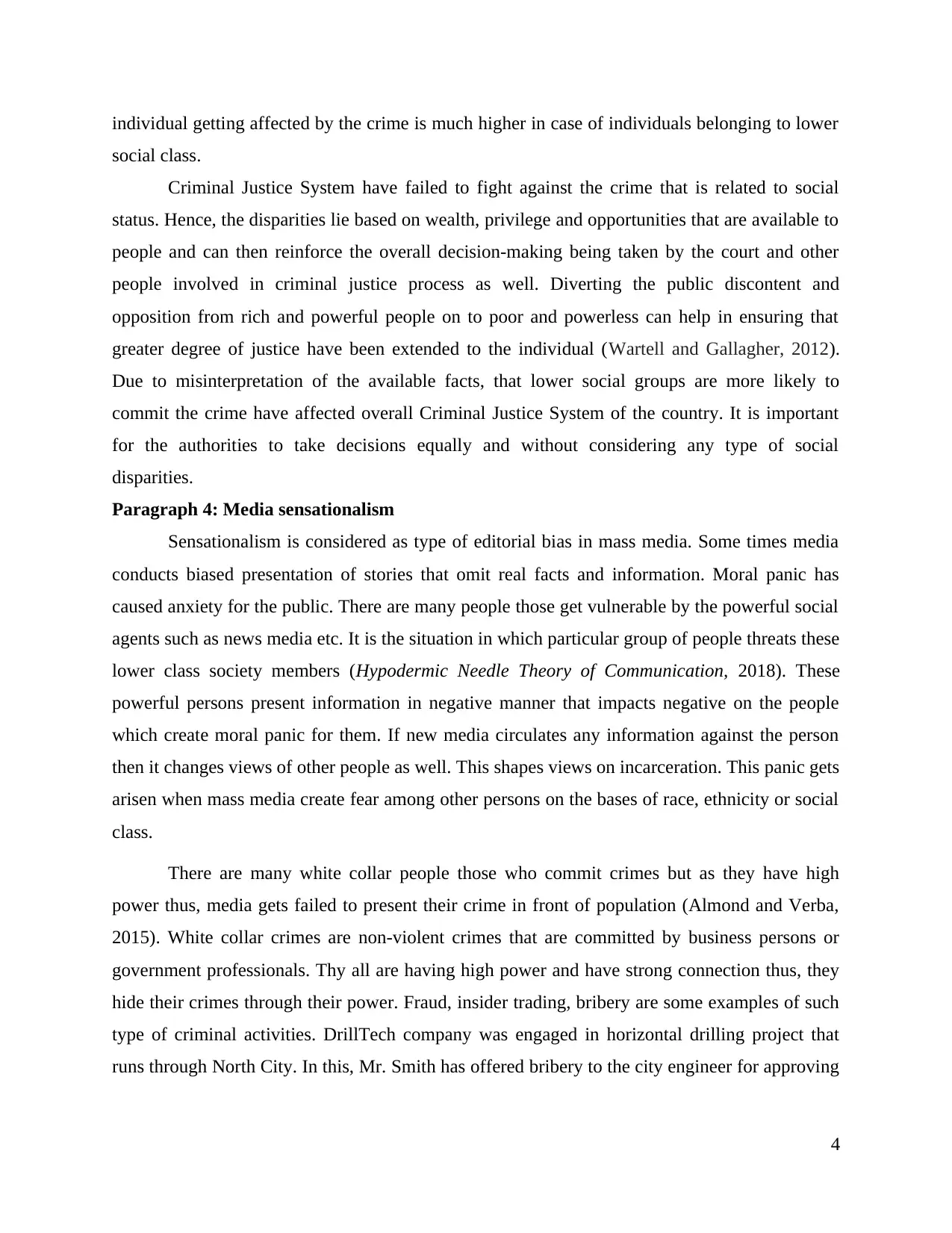
individual getting affected by the crime is much higher in case of individuals belonging to lower
social class.
Criminal Justice System have failed to fight against the crime that is related to social
status. Hence, the disparities lie based on wealth, privilege and opportunities that are available to
people and can then reinforce the overall decision-making being taken by the court and other
people involved in criminal justice process as well. Diverting the public discontent and
opposition from rich and powerful people on to poor and powerless can help in ensuring that
greater degree of justice have been extended to the individual (Wartell and Gallagher, 2012).
Due to misinterpretation of the available facts, that lower social groups are more likely to
commit the crime have affected overall Criminal Justice System of the country. It is important
for the authorities to take decisions equally and without considering any type of social
disparities.
Paragraph 4: Media sensationalism
Sensationalism is considered as type of editorial bias in mass media. Some times media
conducts biased presentation of stories that omit real facts and information. Moral panic has
caused anxiety for the public. There are many people those get vulnerable by the powerful social
agents such as news media etc. It is the situation in which particular group of people threats these
lower class society members (Hypodermic Needle Theory of Communication, 2018). These
powerful persons present information in negative manner that impacts negative on the people
which create moral panic for them. If new media circulates any information against the person
then it changes views of other people as well. This shapes views on incarceration. This panic gets
arisen when mass media create fear among other persons on the bases of race, ethnicity or social
class.
There are many white collar people those who commit crimes but as they have high
power thus, media gets failed to present their crime in front of population (Almond and Verba,
2015). White collar crimes are non-violent crimes that are committed by business persons or
government professionals. Thy all are having high power and have strong connection thus, they
hide their crimes through their power. Fraud, insider trading, bribery are some examples of such
type of criminal activities. DrillTech company was engaged in horizontal drilling project that
runs through North City. In this, Mr. Smith has offered bribery to the city engineer for approving
4
social class.
Criminal Justice System have failed to fight against the crime that is related to social
status. Hence, the disparities lie based on wealth, privilege and opportunities that are available to
people and can then reinforce the overall decision-making being taken by the court and other
people involved in criminal justice process as well. Diverting the public discontent and
opposition from rich and powerful people on to poor and powerless can help in ensuring that
greater degree of justice have been extended to the individual (Wartell and Gallagher, 2012).
Due to misinterpretation of the available facts, that lower social groups are more likely to
commit the crime have affected overall Criminal Justice System of the country. It is important
for the authorities to take decisions equally and without considering any type of social
disparities.
Paragraph 4: Media sensationalism
Sensationalism is considered as type of editorial bias in mass media. Some times media
conducts biased presentation of stories that omit real facts and information. Moral panic has
caused anxiety for the public. There are many people those get vulnerable by the powerful social
agents such as news media etc. It is the situation in which particular group of people threats these
lower class society members (Hypodermic Needle Theory of Communication, 2018). These
powerful persons present information in negative manner that impacts negative on the people
which create moral panic for them. If new media circulates any information against the person
then it changes views of other people as well. This shapes views on incarceration. This panic gets
arisen when mass media create fear among other persons on the bases of race, ethnicity or social
class.
There are many white collar people those who commit crimes but as they have high
power thus, media gets failed to present their crime in front of population (Almond and Verba,
2015). White collar crimes are non-violent crimes that are committed by business persons or
government professionals. Thy all are having high power and have strong connection thus, they
hide their crimes through their power. Fraud, insider trading, bribery are some examples of such
type of criminal activities. DrillTech company was engaged in horizontal drilling project that
runs through North City. In this, Mr. Smith has offered bribery to the city engineer for approving
4
⊘ This is a preview!⊘
Do you want full access?
Subscribe today to unlock all pages.

Trusted by 1+ million students worldwide
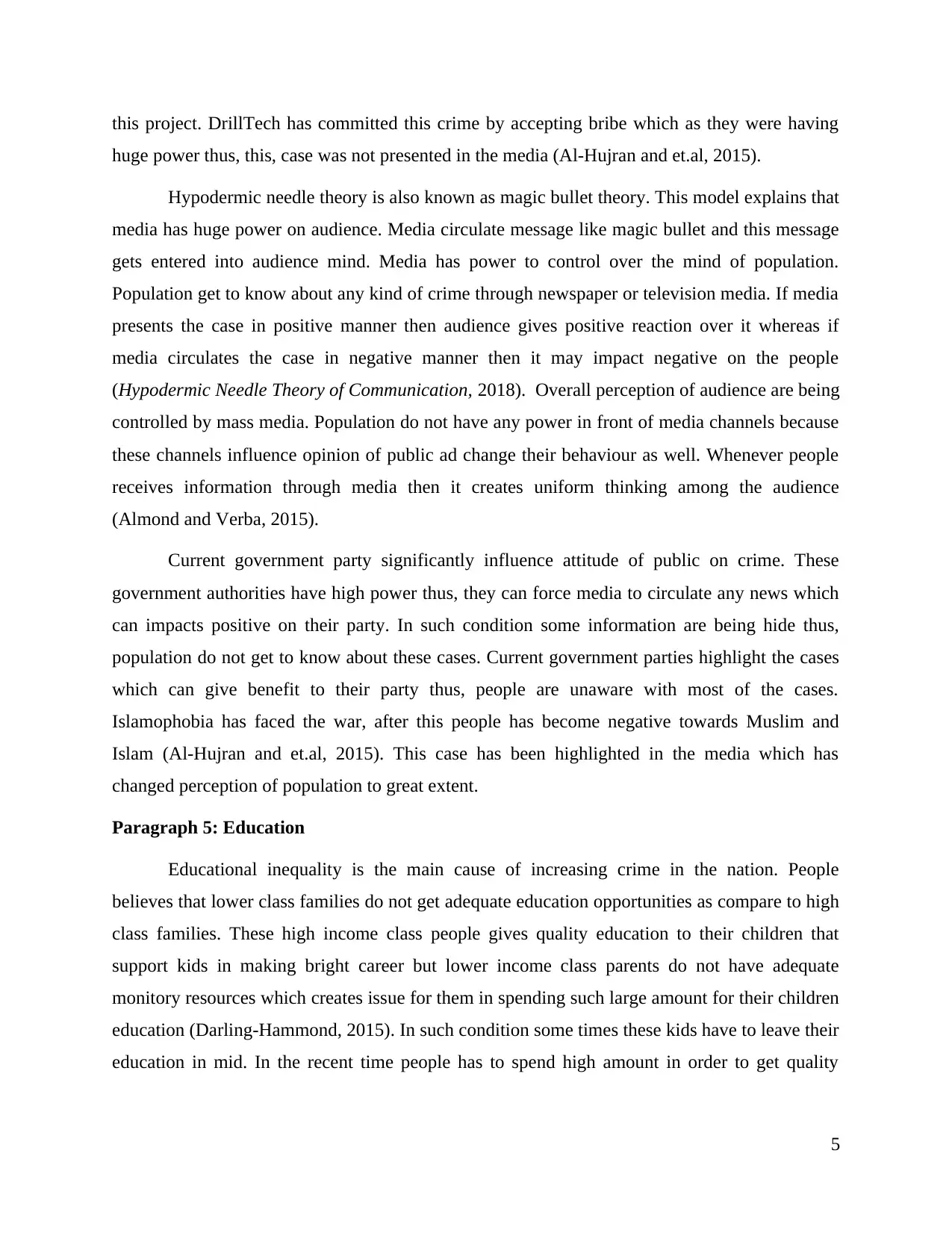
this project. DrillTech has committed this crime by accepting bribe which as they were having
huge power thus, this, case was not presented in the media (Al-Hujran and et.al, 2015).
Hypodermic needle theory is also known as magic bullet theory. This model explains that
media has huge power on audience. Media circulate message like magic bullet and this message
gets entered into audience mind. Media has power to control over the mind of population.
Population get to know about any kind of crime through newspaper or television media. If media
presents the case in positive manner then audience gives positive reaction over it whereas if
media circulates the case in negative manner then it may impact negative on the people
(Hypodermic Needle Theory of Communication, 2018). Overall perception of audience are being
controlled by mass media. Population do not have any power in front of media channels because
these channels influence opinion of public ad change their behaviour as well. Whenever people
receives information through media then it creates uniform thinking among the audience
(Almond and Verba, 2015).
Current government party significantly influence attitude of public on crime. These
government authorities have high power thus, they can force media to circulate any news which
can impacts positive on their party. In such condition some information are being hide thus,
population do not get to know about these cases. Current government parties highlight the cases
which can give benefit to their party thus, people are unaware with most of the cases.
Islamophobia has faced the war, after this people has become negative towards Muslim and
Islam (Al-Hujran and et.al, 2015). This case has been highlighted in the media which has
changed perception of population to great extent.
Paragraph 5: Education
Educational inequality is the main cause of increasing crime in the nation. People
believes that lower class families do not get adequate education opportunities as compare to high
class families. These high income class people gives quality education to their children that
support kids in making bright career but lower income class parents do not have adequate
monitory resources which creates issue for them in spending such large amount for their children
education (Darling-Hammond, 2015). In such condition some times these kids have to leave their
education in mid. In the recent time people has to spend high amount in order to get quality
5
huge power thus, this, case was not presented in the media (Al-Hujran and et.al, 2015).
Hypodermic needle theory is also known as magic bullet theory. This model explains that
media has huge power on audience. Media circulate message like magic bullet and this message
gets entered into audience mind. Media has power to control over the mind of population.
Population get to know about any kind of crime through newspaper or television media. If media
presents the case in positive manner then audience gives positive reaction over it whereas if
media circulates the case in negative manner then it may impact negative on the people
(Hypodermic Needle Theory of Communication, 2018). Overall perception of audience are being
controlled by mass media. Population do not have any power in front of media channels because
these channels influence opinion of public ad change their behaviour as well. Whenever people
receives information through media then it creates uniform thinking among the audience
(Almond and Verba, 2015).
Current government party significantly influence attitude of public on crime. These
government authorities have high power thus, they can force media to circulate any news which
can impacts positive on their party. In such condition some information are being hide thus,
population do not get to know about these cases. Current government parties highlight the cases
which can give benefit to their party thus, people are unaware with most of the cases.
Islamophobia has faced the war, after this people has become negative towards Muslim and
Islam (Al-Hujran and et.al, 2015). This case has been highlighted in the media which has
changed perception of population to great extent.
Paragraph 5: Education
Educational inequality is the main cause of increasing crime in the nation. People
believes that lower class families do not get adequate education opportunities as compare to high
class families. These high income class people gives quality education to their children that
support kids in making bright career but lower income class parents do not have adequate
monitory resources which creates issue for them in spending such large amount for their children
education (Darling-Hammond, 2015). In such condition some times these kids have to leave their
education in mid. In the recent time people has to spend high amount in order to get quality
5
Paraphrase This Document
Need a fresh take? Get an instant paraphrase of this document with our AI Paraphraser

knowledge. If parents are unable to spend such large amount then it creates inequality in the
educational institutes which force children to move towards crime.
Educational activity opens more opportunities for the learners and give them chance to
make their own carer. But due to inequalities some kids fail to get adequate knowledge in the
educational institutes (Egalite, 2016). Sometimes teachers promote to the students who belong
from high class families. This increase feeling of anxiety among lower class students and they
move towards crime. Parental income directly affects academic outcome of the children. Parents
those who have high income sources can admit their kids to the high school where they can get
high opportunities and can build their career. They spend money and send to their children to
such places where their kids can participants in extracurricular activities at school. This enhances
confidence of the person and they become more interactive. This helps the person in gaining
more opportunities and making a bright future (How Family Background Influences Student
Achievement, 2016). But the parents those who do not have adequate income sources or they
struggle economically. These people have no time to check homework of their kids or send them
to extracurricular activities. In such condition these kids start doing jobs in the early age before
completing their education. This impacts on their career sometimes these people gets failed to
get good job on time (Darling-Hammond, 2015). family background is strongly related with
overall success of kids. If parents are paying attention on performance of the learners then these
kids can perform well in classes and can gain success in the future
CONCLUSION
It can be concluded from the above report that there is an existence of social disparities in
the country which not only affect the overall aspects of society but also have greater impact on
Criminal Justice System of the country. It has been stated by the formation or structure of the
society that, people belonging to lower social status have higher tendency to perform stealing,
robbery or indulge in other criminal activities. The biasness can also be noticed in handling of
offenders in the prison as people with high social status are given better treatment in comparison
to the one who belongs to lower social class. Education and media also play an important role in
it in order to assess that whether people belonging to ethical minorities are more prone to
conduct criminal activities or not.
6
educational institutes which force children to move towards crime.
Educational activity opens more opportunities for the learners and give them chance to
make their own carer. But due to inequalities some kids fail to get adequate knowledge in the
educational institutes (Egalite, 2016). Sometimes teachers promote to the students who belong
from high class families. This increase feeling of anxiety among lower class students and they
move towards crime. Parental income directly affects academic outcome of the children. Parents
those who have high income sources can admit their kids to the high school where they can get
high opportunities and can build their career. They spend money and send to their children to
such places where their kids can participants in extracurricular activities at school. This enhances
confidence of the person and they become more interactive. This helps the person in gaining
more opportunities and making a bright future (How Family Background Influences Student
Achievement, 2016). But the parents those who do not have adequate income sources or they
struggle economically. These people have no time to check homework of their kids or send them
to extracurricular activities. In such condition these kids start doing jobs in the early age before
completing their education. This impacts on their career sometimes these people gets failed to
get good job on time (Darling-Hammond, 2015). family background is strongly related with
overall success of kids. If parents are paying attention on performance of the learners then these
kids can perform well in classes and can gain success in the future
CONCLUSION
It can be concluded from the above report that there is an existence of social disparities in
the country which not only affect the overall aspects of society but also have greater impact on
Criminal Justice System of the country. It has been stated by the formation or structure of the
society that, people belonging to lower social status have higher tendency to perform stealing,
robbery or indulge in other criminal activities. The biasness can also be noticed in handling of
offenders in the prison as people with high social status are given better treatment in comparison
to the one who belongs to lower social class. Education and media also play an important role in
it in order to assess that whether people belonging to ethical minorities are more prone to
conduct criminal activities or not.
6
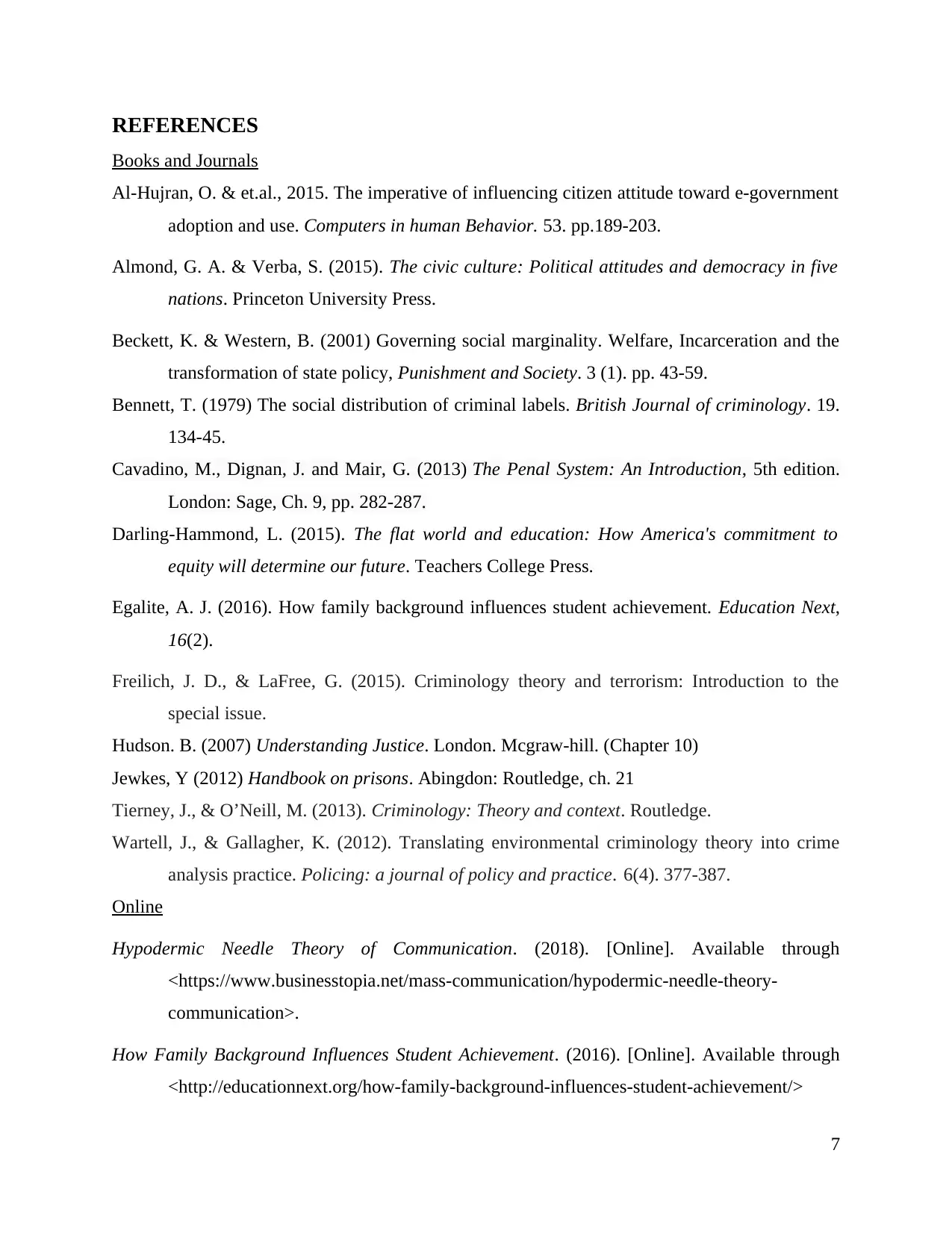
REFERENCES
Books and Journals
Al-Hujran, O. & et.al., 2015. The imperative of influencing citizen attitude toward e-government
adoption and use. Computers in human Behavior. 53. pp.189-203.
Almond, G. A. & Verba, S. (2015). The civic culture: Political attitudes and democracy in five
nations. Princeton University Press.
Beckett, K. & Western, B. (2001) Governing social marginality. Welfare, Incarceration and the
transformation of state policy, Punishment and Society. 3 (1). pp. 43-59.
Bennett, T. (1979) The social distribution of criminal labels. British Journal of criminology. 19.
134-45.
Cavadino, M., Dignan, J. and Mair, G. (2013) The Penal System: An Introduction, 5th edition.
London: Sage, Ch. 9, pp. 282-287.
Darling-Hammond, L. (2015). The flat world and education: How America's commitment to
equity will determine our future. Teachers College Press.
Egalite, A. J. (2016). How family background influences student achievement. Education Next,
16(2).
Freilich, J. D., & LaFree, G. (2015). Criminology theory and terrorism: Introduction to the
special issue.
Hudson. B. (2007) Understanding Justice. London. Mcgraw-hill. (Chapter 10)
Jewkes, Y (2012) Handbook on prisons. Abingdon: Routledge, ch. 21
Tierney, J., & O’Neill, M. (2013). Criminology: Theory and context. Routledge.
Wartell, J., & Gallagher, K. (2012). Translating environmental criminology theory into crime
analysis practice. Policing: a journal of policy and practice. 6(4). 377-387.
Online
Hypodermic Needle Theory of Communication. (2018). [Online]. Available through
<https://www.businesstopia.net/mass-communication/hypodermic-needle-theory-
communication>.
How Family Background Influences Student Achievement. (2016). [Online]. Available through
<http://educationnext.org/how-family-background-influences-student-achievement/>
7
Books and Journals
Al-Hujran, O. & et.al., 2015. The imperative of influencing citizen attitude toward e-government
adoption and use. Computers in human Behavior. 53. pp.189-203.
Almond, G. A. & Verba, S. (2015). The civic culture: Political attitudes and democracy in five
nations. Princeton University Press.
Beckett, K. & Western, B. (2001) Governing social marginality. Welfare, Incarceration and the
transformation of state policy, Punishment and Society. 3 (1). pp. 43-59.
Bennett, T. (1979) The social distribution of criminal labels. British Journal of criminology. 19.
134-45.
Cavadino, M., Dignan, J. and Mair, G. (2013) The Penal System: An Introduction, 5th edition.
London: Sage, Ch. 9, pp. 282-287.
Darling-Hammond, L. (2015). The flat world and education: How America's commitment to
equity will determine our future. Teachers College Press.
Egalite, A. J. (2016). How family background influences student achievement. Education Next,
16(2).
Freilich, J. D., & LaFree, G. (2015). Criminology theory and terrorism: Introduction to the
special issue.
Hudson. B. (2007) Understanding Justice. London. Mcgraw-hill. (Chapter 10)
Jewkes, Y (2012) Handbook on prisons. Abingdon: Routledge, ch. 21
Tierney, J., & O’Neill, M. (2013). Criminology: Theory and context. Routledge.
Wartell, J., & Gallagher, K. (2012). Translating environmental criminology theory into crime
analysis practice. Policing: a journal of policy and practice. 6(4). 377-387.
Online
Hypodermic Needle Theory of Communication. (2018). [Online]. Available through
<https://www.businesstopia.net/mass-communication/hypodermic-needle-theory-
communication>.
How Family Background Influences Student Achievement. (2016). [Online]. Available through
<http://educationnext.org/how-family-background-influences-student-achievement/>
7
⊘ This is a preview!⊘
Do you want full access?
Subscribe today to unlock all pages.

Trusted by 1+ million students worldwide
1 out of 9
Related Documents
Your All-in-One AI-Powered Toolkit for Academic Success.
+13062052269
info@desklib.com
Available 24*7 on WhatsApp / Email
![[object Object]](/_next/static/media/star-bottom.7253800d.svg)
Unlock your academic potential
Copyright © 2020–2025 A2Z Services. All Rights Reserved. Developed and managed by ZUCOL.





